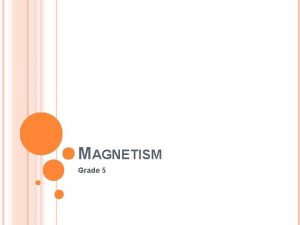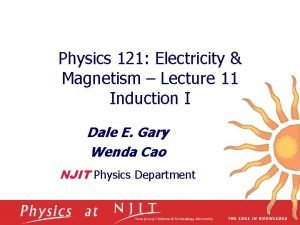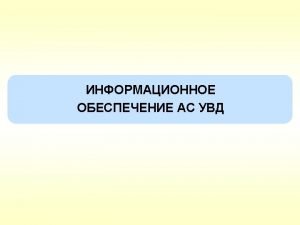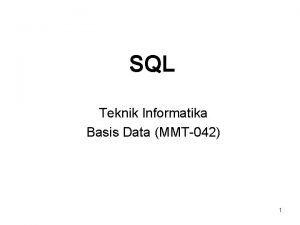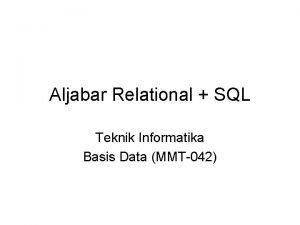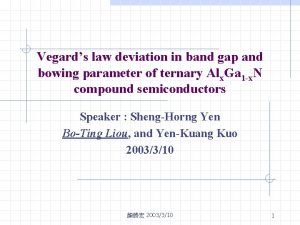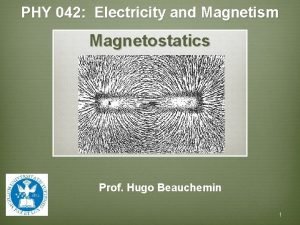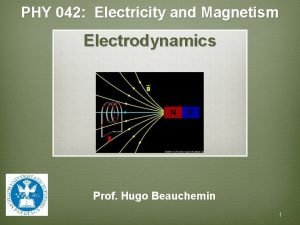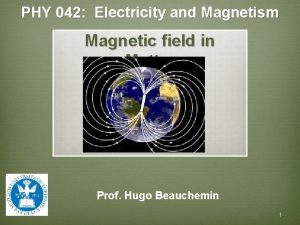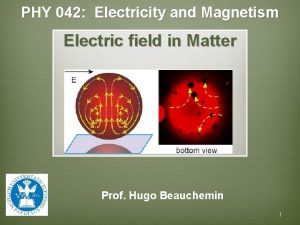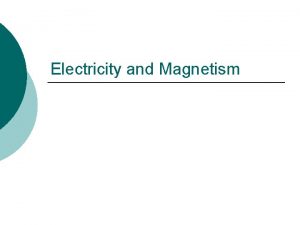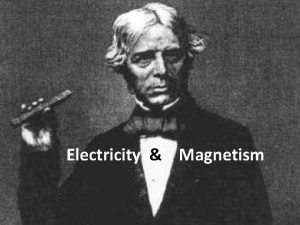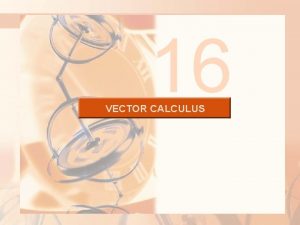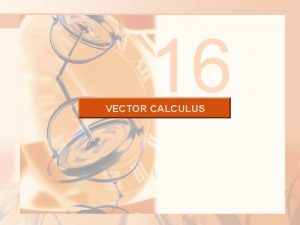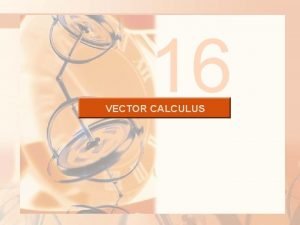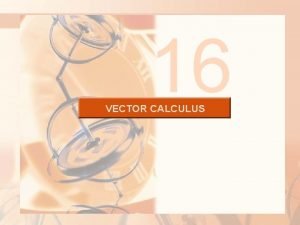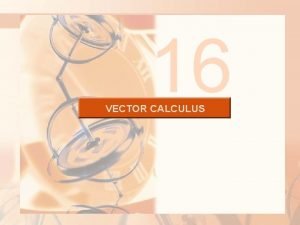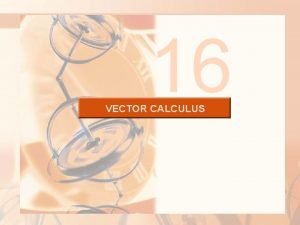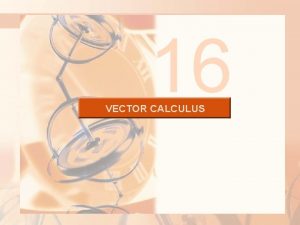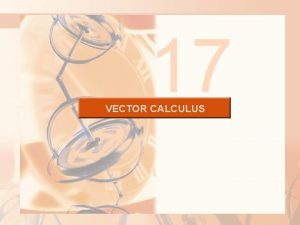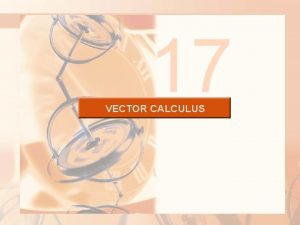PHY 042 Electricity and Magnetism Vector calculus review
























- Slides: 24

PHY 042: Electricity and Magnetism Vector calculus: review Prof. Hugo Beauchemin

Introduction to vector calculus v The aim of the course is to understand Maxwell’s equations v Start with their mathematical structures v Need to understand: v What vectors are, v Differentiation of vectors fields, v Integration of vector fields, v How to exploit symmetries of a system to simplify the formalization of a problem, v Theorems about vector fields.

Definition of vectors Use same concept in various contexts v Vectors are abstract mathematical objects defining linearity from the properties of two operations: v +: (V, V) V v : (S, V) Can represent same vector in various ways V E. g. : Will be used to formalize electric and magnetic fields v Properties of these two operations define the set of objects (vectors), that have the structure allowing for linear combinations

Representation of vectors v A subset of all vectors of a given kind can be used to provide a unique decomposition for any other vector of that kind Basis of a vector space v It can serve as a references for representing a vector in a convenient coordinate system v Orthonormal basis v Spectral decomposition v The laws of physics must be independent of the choice of the coordinate system (same physics for any observer) v Will exploit this requirement to formulate problems in the coordinate system that is the most convenient

Special vector functions v Two special functions of vectors (taking two vectors as input): v Dot or Scalar product: : (V, V) S v Geometrical interpretation: projection of a vector on another one v E. g. : The components of a vector on the basis of a vector space v Allow to define the norm of a vector v Cross or Vector product: ×: (V, V) V v Geometrical interpretation: area of a parallelogram v Allow to define the determinant of a matrix v Will use the determinant to compute cross product! v Don’t forget the Right-hand rule!!! v Since the cross product yields a vector, we can define two different triple products: v Dot product with a cross product v Cross product with a cross product

Derivative v Vectors and vector fields can vary in space and in time v Each component can be a function of x, y, z and t v E. g. : v We can differentiate vectors. This changes both the norm and the direction of the vector v If we differentiate E with respect to t, then each scalar functions Ex, Ey and Ez will change, and thus the norm and the direction of the vector field E will change v We know how to differentiate multivariate scalar functions v This is vector laden!

Gradient v The variation of f between 2 nearby points (x, y, z) and (x’, y’. z’) is the scalar product of the gradient of f with the displacement vector between these nearby points v To be able to differentiate a function, a norm must be defined on the vector space v The gradient is a vector v It has a norm and a direction v Interpretation: v Point in direction of biggest increase of f (x, y, z) v Its norm gives the rate of the increase along the largest increase direction v Null variation of df: v Equipotential v Stationary points

Differential Operator v Recall: vectors are not arrows but abstract entities satisfying linearity operations We can define a vector differential operator: v Define vector differential operator in 3 D as: o Is there a difference between and ? Q: Why do we speak of a “vector operator”? A: It is an object that acts differently on each component of a vector to transform these components according to a well defined operation. Allows to define the derivative of multivariate vector fields!

Divergence v The divergence of a vector field is a scalar! v It is a number telling how much a vector is spreading out from a point, i. e. how much the lines of the field diverge from this point Note: These are not picture of the divergence of a field but picture of fields with different divergences.

Curl v The curl of a vector field is a vector! v The norm tells you how much the field is curling around an axis at a given point v The direction tells you around which axis the original field is curling v Use the right-hand rule to get this axis

Sum and product rules v Sum rule: The derivative of a sum of vector is given by the sum of the derivative of the elements of the sum v Thanks to the linearity of the vector differential operator and of the vectors summed v Product rule: many possibilities v v The product of two functions (vector or scalar) to be differentiated can be: v Scalar: or v Vector: or The derivative of a scalar function is a vector v Gradient v The derivative of a vector function is a: v Scalar: the divergence v Vector: the curl

Second derivative v Equation with 2 nd derivative are often used in physics v Field equations in function of potential such as Poisson v Characterize an extremum v There are 5 possibilities of second derivative Divergence Gradient of a scalar Vector Curl Divergence of a vector Scalar Curl of a vector Vector Gradient Divergence Curl

Integral vector calculus I v Problem to solve: v We want to perform definite integrals (integrals with specific boundary conditions) of vector fields Generalize the Fundamental Theorem of Calculus (FTC) v Boundaries: v The boundaries a and b enclose, limit, the integral interval. If the integral cover many dimensions (or just 1 D but embedded in an higher dimensional space), boundaries can be defined as: v Line (path) integral v Surface integral v Volume integral

v Integral vector calculus II Path integral: v An infinitesimal element along the path on which the integral is to be taken v Note: is constrained to be on the path so v Can be parameterized by one variable (e. g. time t) v Close Integral v From the FTC, if a=b, the integral is null, need not be the case if the integral is over a close path Example? Work done on a system by a non-conservative force such as friction

Integral over a path (1 D) v To integrate a vector function over a given path P, we need: 1. Parameterize the path as a 1 variable function 2. Project the vector function onto the path 3. Integrate the product Only the lines of field along the path matter A B Only the components of field parallel to the path matter

Conservative forces v A force is conservative if the work it does along a path P is independent of that path, and only depends on the starting and ending points (path integral of F just depends on a and b) v If the vector field to integrate is a gradient, then this vector field describes a conservative force v This is just a special case of vector function Conservative -Independent of P -W=W’ -E. g. Falling stone Non-Conservative -Depends on P -W≠W’ -E. g. Pushing a box on the ground P P’

Surface integrals (2 D) v What if the function is to be integrated over a 2 D surface rather than a 1 D path? v Need to define an infinitesimal patch of area constrained to the surface to integrate over and compute v Q: How to define a vector for a surface element da ? v A: The direction is set by the normal to the patch area Provide a measure of the amount of F that flows through S Conventions: • S is closed: da is outward to the enclosed surfac • S is bounded by C: da obtained by right-hand rul

A question: Q: What is the difference between the circulation of a vector field and the flux of the vector field , i. e. the difference between and when the surface S is formed by a closed curve C? A: The circulation is the integration of the tangential component of the vector field on C and the flux is the integral of the normal component to C.

v Flux-divergence theorem I claimed in intro that the formulation of Maxwell’s equations in terms of curl and divergences are equivalent to their formulation in terms of flux and circulation v This is established by theorems v Flux-divergence (a. k. a. Gauss or Green theorem): v The integral of a derivative over a volume is equal to the primitive at the boundary, i. e. the whole surface enclosing that volume Measure of the outgoing divergence of a field from a point per unit volume Flux across a surface

Stokes theorem v Another version of the fundamental theorem of calculus: v The integral of a derivative over a surface is equal to its primitive at the boundary of the surface, i. e. over the circulation enclosing the surface Measure of the total amount of “swirl” of a vector field inside an area S Circulation of the field at the boundary

Spherical coordinates v Vectors are independent of coordinates (same vectors in different bases) v Can exploit the symmetry of a system to simplify the problem v The price to pay is to have a reference system that changes from point to point in the space

Cylindrical coordinates v Useful when you have a field generated by a wire, or by a solenoid for example v ATLAS/CMS detectors have cylindrical symmetry Like spherical coordinates but with

Helmholtz theorem v Generally, in E&M, we don’t know what the electric and magnetic fields are, but we know how they vary v Differential equations (Maxwell’s equation) v Is the divergence and the curl of a vector field determine the field at every point of space where these derivatives are defined and known? v Thm: A field is uniquely determined by its divergence, its curl (in a finite volume) and its boundary conditions Charge source Current source E&M: Use experiments to find relationships between sources and field variations

Potentials v Under certain conditions, fields can be obtained from the knowledge of the variation of underlying functions called potentials v Theorem 1: If the curl of a vector field is null: The circulation of the field over a closed path is null v The field is a conservative force v The field can be expressed as the gradient of a scalar potential v v Theorem 2: If the divergence of a field is null: The flux is null over a closed surface v The field can be expressed as the curl of a vector potential v For ANY field (always!):
 Physics 102 electricity and magnetism
Physics 102 electricity and magnetism Ib physics topic 5 question bank
Ib physics topic 5 question bank Magnetism
Magnetism Electricity and magnetism jeopardy
Electricity and magnetism jeopardy Sph3u electricity and magnetism
Sph3u electricity and magnetism Electromagnet experiment hypothesis
Electromagnet experiment hypothesis Electric susceptibility formula
Electric susceptibility formula Electricity and magnetism grade 5
Electricity and magnetism grade 5 Electricity and magnetism
Electricity and magnetism Electric fuse and circuit breaker graphic organizer
Electric fuse and circuit breaker graphic organizer Electricity and magnetism
Electricity and magnetism Electricity and magnetism
Electricity and magnetism Electricity and magnetism
Electricity and magnetism Electricity and magnetism vocabulary
Electricity and magnetism vocabulary Static electricity and current electricity
Static electricity and current electricity Current electricity
Current electricity Sac country
Sac country 042-68-4425
042-68-4425 Mmt-042
Mmt-042 Mmt-042
Mmt-042 Pad-042
Pad-042 Nrg-gy018
Nrg-gy018 Dori-042
Dori-042 0 042
0 042 Pad-042
Pad-042







